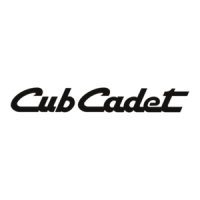*
WARNING:
Failure to use this starting pro-
cedure could cause sparking, and
the gases in either battery could ex-plode.
TIRES
Keep the pneumatic tires properly inflated. Over-
inflation will cause operator discomfort. Under-
inflation will cause short tire life.
Inflate the front and rear tires for normal or heavy
load operations as shown in the following table.
Tire Size
Front Tires
16 x 6.50-8
Rear Tires
23 x 10.50-12
Pounds per square inch
12
10
1. Working outdoors, drain all fuel from the fuel
tank. Use a clean dry cloth to absorb the small
amount of fuel remaining in the tank, then run
the engine until all fuel in the carburetor is ex-
hausted.
2. Drain all the oil from the crankcase (this
should be done after the engine has been
operated and is still warm) and refill the crank-
case with clean new oil.3.
Disconnect the spark plug wires and remove
the spark plugs from the cylinders. Pour about
2 or 3 tablespoons of engine oil into each
cylinder, and then turn the engine over several
times to spread out the oil. Replace the spark
plugs but do not connect the wires.4.
Clean the engine and the entire tractor
thoroughly.5.
Lubricate all lubrication points and wipe the
entire machine with an oiled rag in order to
protect the surfaces.6.
Follow battery storage instructions on page
19.7.
Protect tires and seat from sunlight. Inflate
tires at regular intervals.
Always see that the tire valve caps are in place
and tightened securely to prevent loss of air and
protect the valve core and stem.
Do not overload the tractor tires by mounting
equipment on the tractor which exceeds the load
capacity of the size of the tires on the tractor.
OPTIONAL
EQUIPMENTAND
ACCESSORIES
Mounting Tires On The RimAfter
mounting a new or old tire on the rim, inflate
it to 20 pounds pressure to seat the tire bead onthe
rim flange. Then deflate the tire to the correctoperating
pressure.
NOTE: After the first 10 hours of operation, check
and retorque the wheel lug nuts (both sides) to 35Ibf.
ft. to make sure they have seated properly.
When you purchased your tractor, you probably
had it completely equipped for your particular
needs at the time. However, later you may wish to
obtain optional equipment or accessories. These
items and other allied equipment can be pur-
chased from, and installed by, your authorizeddealer.
The tractor is used for so many different types ofwork,
and because it is called on to operate under
so many different conditions, a variety of equip-
ment is available to adapt it to the requirements of
the user. Refer to equipment catalog.
If the machine is to be inoperative for a periodlonger
than 30 days, the following procedures arerecommended:
20

